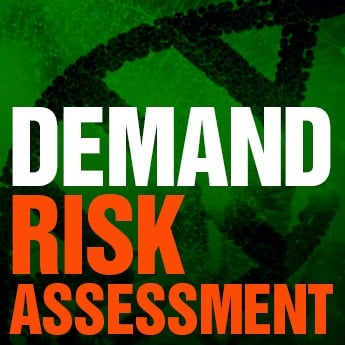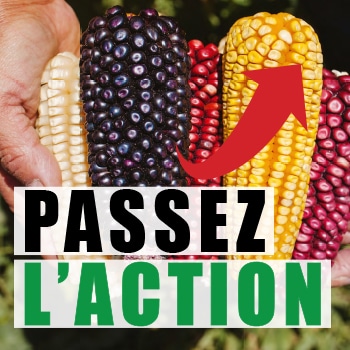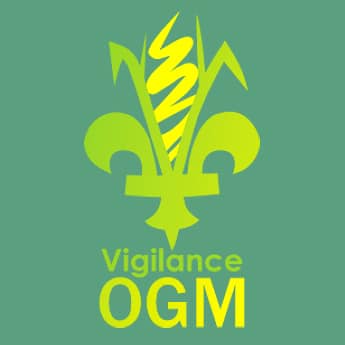GM Fish
A genetically modified (GM or genetically engineered) Atlantic salmon – engineered to grow faster using a growth hormone gene from Chinook salmon and genetic material from ocean pout – was the world’s first commercialized GM food animal but production is paused.
Market Status
GM salmon production halted.
September 2024: The US company AquaBounty is currently not producing any genetically modified (GM or genetically engineered) fish and is selling its only working GM salmon “tank-farms” in Prince Edward Island (Canada) and in Indiana (US). However, the company says they plan to build a new on-land GM salmon facility, in Ohio, US. Its GM Atlantic salmon was the world’s GM food animal and was first sold in Canada in 2017, unlabelled.
October 2, 2024 – CBAN Press Release: GM Fish Factory in P.E.I. for Sale: Taxpayers Should Get Their Money Back
- CBAN Factsheet: GM Salmon Production Halted, September 2024.
Updates
October 2, 2024 – CBAN Press Release: GM Fish Factory in P.E.I. for Sale: Taxpayers Should Get Their Money Back
- CBAN Factsheet: GM Salmon Production Halted, September 2024.

AquaBounty has closed its Rollo Bay facility in Canada. Sept 2024.
July 2024: AquaBounty has sold its land-based facility in Albany, Indiana, for $9.5 million to the US land-based salmon farming company Superior Fresh which only sells non-GM salmon, fed non-GM fish food.
July 2024: Sylvia Wulf, the former CEO of AquaBounty Technologies, is now interim executive vice president of the industry lobby group Biotechnology Innovation Organization (BIO) (formally called the Biotechnology Industry Organization).
May 23, 2024: AquaBounty has closed its remaining “tank farm” of GM salmon and is not currently producing any GM fish. GM salmon production is on hold until the company’s planned Ohio facility is constructed: “With the farm now empty of fish, we completed the process in April to shut down and secure all of the internal systems so that they are ready for restart by a new owner.” The company posted net losses of USD 11.2 million in Q1 2024, up from the USD 6.5 million net loss it posted in the same quarter of 2023.
February 14, 2024: AquaBounty is now selling its only remaining genetically modified salmon “tank farm”, though they say they will still build their new facility which is 30% finished.
February 7, 2023: In a major turnaround, the US company AquaBounty says it will stop producing its controversial genetically modified (GM or genetically engineered) Atlantic salmon in Prince Edward Island (PEI), Canada.
- Press Release: AquaBounty to stop producing GM salmon in Canada, as world’s first GM food animal struggles to find a market
- CBAN Factsheet: Genetically Engineered Salmon in Canada: Update, April 2023
- Background: AquaBounty Update 2023
Background
The company AquaBounty has genetically engineered Atlantic salmon to grow faster. The salmon has a growth hormone gene from Chinook salmon and genetic material from ocean pout (an eel-like creature). The company says its “AquAdvantage” salmon grow to market-size twice as fast as other farmed salmon.
On May 19, 2016, Health Canada approved the genetically modified (GM, also called genetically engineered) Atlantic salmon for human consumption. This followed a 2013 decision by the Minister of the Environment to approve commercial production of GM salmon in Canada, in land-based facilities. The 2013 decision was however challenged in court with an outcome that resulted in a new environmental assessment and an April 2019 approval of GM salmon production at Rollo Bay in PEI. The Rollo Bay site is the first GM fish factory in Canada and only the second in the world but in 2023, the company announced that it will no longer produce GM fish in Canada. AquaBounty now produces GM salmon in Indiana, US and it is in the first stages of building a larger “tank farm” in Ohio, though there are protests from the local community. AquaBounty has closed its pilot plant in Panama, which was the source of the GM salmon sold in Canada, unlabelled, since June 2017.
Environmental Risks
Because fish can escape from fish farms in the ocean, AquaBounty is only permitted to grow GM salmon on land. While land-based containment is not risk-free, in 2013 Fisheries and Oceans Canada (DFO) concluded that the risk of escape from AquaBounty’s facility is low to moderate. Additionally, if escape happens, the company says that most or all of the GM salmon (98.5% or more) will be sterile (via triploidy) females. (In Canada, experimental genetically engineered animals contaminated the food system by accident in 2002 and 2004. See CBAN’s 2019 report: GM Contamination in Canada).
According to the 2019 risk assessment from DFO, however, AquaBounty now proposes to produce and sell non-GM salmon eggs as well as GM salmon eggs at its P.E.I. factory. DFO made a number of recommendations for production and shipping practices to prevent the accidental mixing of GM and non-GM eggs but these are not requirements.
AquaBounty says its GM fish is “the world’s most sustainable salmon” because it will be produced on land, removing many of the negative ecological impacts of fish farming, and it will be produced closer to urban markets to have a smaller carbon footprint. The company says it will take 25% less feed to get the fast-growing GM salmon to market, requiring less wild fish to be converted into salmon feed.
Health Risks
Critics have long warned that the process of genetic engineering itself could possibly result in increased allergenicity and AquaBounty’s own data point to this potential in their GM salmon. Dr. Michael Hansen, Senior Scientist at Consumers Union US, says, “The FDA is relying on woefully inadequate data. There is sloppy science, small sample sizes, and questionable practices.” For example, the company used insensitive tests to try and measure the levels of growth hormone in the GM salmon and the levels of IGF-1, a hormone linked to a number of cancers.
Canadian Regulation
Unlike GM crops which are approved for environmental release by the Canadian Food Inspection Agency, GM animals are assessed for environmental safety by Environment Canada. In the case of GM fish, the Department of Fisheries and Oceans (DFO) abandoned its work to develop regulations specific to GE fish and, instead, passed the task to Environment Canada under the Canadian Environmental Protection Act. For more information see CBAN’s GMO Inquiry report “Are GM Crops and Foods Well Regulated?”
Global Rejection of GM Fish
- The Canadian Aquaculture Industry Alliance states that their members, who represent “virtually all farmed salmon in Canada” and are some of the biggest aquaculture companies in the world, “do not farm or sell GE farmed salmon, and are not growing or researching GE salmon”.
- Grocery stores in the US are now pledging not to use GM seafood.
- 76 groups in Canada have already registered their opposition to the production of GM fish and fish eggs.
GM Salmon Production in Canada
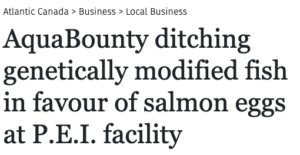 February 2023: In 2023, the company AquaBounty announced that it will no longer produce the genetically modified Atlantic salmon in Canada. It was being raised (annual capacity of 250 metric tonnes) in an on-land “tank farm” at Rollo Bay in PEI. The Rollo Bay facility was opened in 2019, first “harvested” GM salmon in mid-2021, and then stopped producing the fish in 2023.
February 2023: In 2023, the company AquaBounty announced that it will no longer produce the genetically modified Atlantic salmon in Canada. It was being raised (annual capacity of 250 metric tonnes) in an on-land “tank farm” at Rollo Bay in PEI. The Rollo Bay facility was opened in 2019, first “harvested” GM salmon in mid-2021, and then stopped producing the fish in 2023.
GM salmon was first grown by AquaBounty at a small pilot plant in Panama, using GM salmon eggs grown in PEI, but this plant is now closed. The PEI facility was the first of two GM fish factories in the world, both coming online at the same time. The second, and now the only, is in Indiana, US. AquaBounty is now constructing a new factory farm in Ohio, with production capacity of 10,000 metric tons annually, about eight times the size of its currently operating farm in Indiana.
April 2, 2019: The company AquaBounty announced that the Minister of Environment and Climate Change approved the production of genetically modified (GM or genetically engineered) Atlantic salmon at a site in Prince Edward Island. This will be the first factory in Canada to produce GM salmon, which is the world’s first GM food animal. Press Release – April 2, 2019: Minister Approves First Commercial GM Fish Factory: Groups raise concerns over transparency and environmental risk
June 2017: Following a court case and correspondence with environmental groups, the federal government confirmed that AquaBounty did not yet have permission to grow GM salmon at its new facility in Rollo Bay PEI.
- Press Release
- Background information on Rollo Bay’s legal status
- Click here to read the correspondence with the federal government
PEI approves construction of world’s first GM fish plant – June 19, 2017: The Government of Prince Edward Island approved AquaBounty’s “amended” proposal to build the world’s first GM fish factory at Rollo Bay, PEI. Just one year earlier, when the company got approval to buy the facility, the company stated that it would not be used for producing any GM fish. The company now says it plans to grow 250 metric tonnes of GM fish in PEI every year. Read the press release.
Environmental groups ask for new scientific assessment: On June 6, 2017 CBAN and 11 other Canadian environmental organizations called on the Minister of Environment and Climate Change, Minister of Health, and Minister of Fisheries, Oceans and the Canadian Coast Guard, to carry out a toxicity assessment on the company Aquabounty’s proposal to produce GM fish at its facility at Rollo Bay, PEI. Experts originally conducted a risk assessment for Aquabounty’s proposal to manufacture GM salmon eggs at Bay Fortune PEI. However, this study did not include an assessment of the risks posed by their current proposal to commercially produce GM fish. Read the joint letter from 12 environmental organizations. June 6, 2017
PEI groups ask for public hearings: On May 11, 2017, groups in PEI called on the Premier to hold public hearings on the impacts of GM fish production. Click here to see the letter and press release.
- Press Release – April 26, 2017: World’s First GM Fish Factory Could be in Canada
- CBAN’s factsheet, Will PEI be the site of the world’s first GM fish factory? April 25, 2017
On May 19, 2016, AquaBounty’s Environmental Impact Statement stated, “The proposed facility at Rollo Bay West will have no GMO salmon.“ However on April 12, 2017, AquaBounty’s Amended Environmental Impact Statement stated, “AquaBounty will rear AquAdvantage Salmon, a sterile genetically modified salmon, from eyed egg to market size within the production facility.” Letter of approval to Aquabounty from the Government of PEI
AquaBounty
September 2024: AquaBounty is not currently producing GM salmon. US-based AquaBounty has a long-standing research and development facility in Bay Fortune, Prince Edward Island (PEI) where it was producing GM salmon eggs for export to Panama for further research and limited production. AquaBounty closed its pilot plant in Panama in 2019 and built two GM fish factories: one at Rollo Bay, PEI, Canada, and another in Indiana, US. The company has since sold its Indiana facility (2024) and is selling its Rollo Bay site. The company says it will use the funds from these sales to construct a larger “tank farm” in Ohio – however, construction has been on hold since June 2023.
Company Ownership Timeline
- November 2020: ARK Invest, a New York-based investment firm focused solely on “disruptive innovations,” bought a 10.21% stake in AquaBounty Technologies. ARK Invest’s top holding is Tesla.
- October 2019: Intrexon sold its shares to the venture capital firm Third Security led by former Intrexon CEO Randal Kirk. In January 2020, Intrexon changed its name to Precigen Inc. and a new president and chief executive officer took over from Kirk, who was named executive chairman of the board of directors. 42% of AquaBounty now is owned by billionaire venture capitalist Randal Kirk via Third Security.
- 2012: The US-based biotechnology company Intrexon acquired a 48% interest in AquaBounty.
- 2004: AquaBounty Farms was renamed as AquaBounty Technologies Inc., with corporate headquarters in Massachusetts.
- The original research on antifreeze (promoter) proteins was patented by two University professors, Dr. Garth Fletcher from Memorial University Newfoundland and Dr. Choy Hew of the University of Toronto. Dr. Fletcher became Co-Founder, Director, and Corporate Vice President of A/F Protein Inc., and President of A/F Protein Canada Inc – he is Professor Emeritus at the Ocean Sciences Centre of Memorial University of Newfoundland.
AquaBounty Fined in Panama
Press Release: October 28, 2014 – Panama Fines GM Fish Company with Canadian Operation for Violating Environmental Regulations The Government of Panama has fined the company AquaBounty for breaching numerous national environmental laws during its ongoing research and development of a genetically modified (GM) Atlantic salmon. The GM fish eggs were shipped from Canada, provoking fears of environmental contamination in both countries.
- Press Release – November 21, 2013: Complaint in Panama Raises Concerns About GM fish Research in Canada
- Letter to the Minister of the Environment from CBAN, November 21, 2013
- Letter of Support to CIAM’s administrative filing in Panama, alleging violations of environmental regulations. Signed by CBAN, Food & Water Watch, Friends of the Earth, Center for Food Safety, GeneWatch UK, Food & Water Europe.
Allegations of Misleading Advertising in Canada
February 8, 2018 – Press Release: GM Salmon: Allegations of misleading advertising not to be addressed by Canadian Food Inspection Agency. In December 2018, CBAN filed a complaint of AquaBounty’s misleading advertising to the Canadian Food Inspection Agency. The CFIA’s response to CBAN stated, “As Aqua Bounty’s home page www.aquabounty.com is not based in Canada, it does not fall under CFIA jurisdiction.”
Government Funding to AquaBounty
AquaBounty has benefited from at least five federal government loans, one federal government grant, and two provincial government loans including from the federal Atlantic Canada Opportunities Agency (ACOA), the federal Department of Fisheries and Ocean’s Atlantic Fisheries Fund, and PEI Finance. In total, over $8 million was invested by the federal and provincial governments.
As recently as December 2023, the federal government provided AquaBounty with up to $612,000 to support “business productivity and scale-up” at Rollo Bay, and on February 29, 2024, provided AquaBounty with a loan of $158,246, at a 3% interest rate with monthly repayments commencing in April 2025 and maturity in March 2034.
In 2018, the Government of Prince Edward Island (P.E.I) provided a $2.2 million loan to the company AquaBounty, to help it finish construction of the world’s first genetically modified (GM or genetically engineered) fish factory. This is in addition to $818,000 in non-repayable support since 2002 including grants and labour incentives. In July 2016, Island Investment Development Inc. also approved a provincial loan to the company of $717,000. AquaBounty has also received money from the federal government.
In 2009, the federal government Atlantic Canada Opportunities Agency (ACOA) provided AquaBounty Canada Inc. and Aqua Bounty Technologies Inc. with $2.87 million to “improve the culture of reproductively sterile Atlantic salmon” with the objective of “the safe commercial launch of triploid salmon with Atlantic Canada identified as the source for associated commercial benefits, and worldwide distribution of the product.” This agreement provides for a 10% royalty from product sales to the federal government. ACOA also gave the company an unconditionally repayable contribution of $337,000 in April 2016 to develop its hatchery. AquaBounty states that it is not the GM salmon itself that is the subject of royalty repayments, which product sales will provide 10% royalties to the federal government is unknown. CBAN requested information on the royalty agreement from the Minister Innovation, Science and Economic Development – you can read the response here.
- For more information read CBAN’s article A fishy return on investment: The policy collision over genetically modified salmon, Canadian Centre for Policy Alternatives, The Monitor, September/October 2018.
-
How Canadians Bankrolled the World’s First Genetically Engineered Food Animal: Taxpayers have invested $8.2 million in the development of a rapid-growth salmon that first hit shelves last year. Christopher Pollon, Vice Magazine, March 21 2018.
Past Developments on GM Salmon
November 2022: Bill S-5, an Act to amend the Canadian Environmental Protection Act, 1999 (CEPA) has been sent to the House of Commons Standing Committee on Environment and Sustainable Development for review. CEPA, which is meant to protect human health and the environment from toxic chemicals and genetically engineered animals, is, after 23 years, being reviewed by Parliament. In a positive move, the Senate of Canada, in reviewing Bill S-5 earlier this year, made 24 amendments to the Bill including on GE animals. For details see the press release from Nature Canada. At the same time, however, Environment and Climate Change Canada have also launched a “pre-consultation” on modernizing the New Substances Notification Regulations which pertain to GM animals under CEPA. Click here to read CBAN’s comments on these regulations.
November 8, 2022: On November 8, shares in the GM fish company AquaBounty were trading at 65 cents, down from over $23 per share in 2017. Share price was below a dollar for more than 30 days. The US Nasdaq exchange which hosts the shares of GM salmon company AquaBounty Technologies has threatened the company with delisting if it does not lift its low share price soon.
October 25, 2022: Former AquaBounty employee Braydon Humphrey (2018-2020) leaked 113 photos and videos of disturbing health and safety practices inside AquaBounty’s GM salmon factory in Indiana, US:
- Photos show “persistent contamination” of salmon tanks with unsafe levels of fiberglass particles and heavy metals.
- The plant discharged high levels of ammonia in water into the surrounding watershed.
- Videos show leaks of aerosolized hydrochloric acid, an issue Humphrey says continued even after he reported it.
- There was a lack of safe drinking water and basic first aid materials for employees onsite.
- AquaBounty lost one third of its initial GM salmon stock during its first-feeding systems due to fungus that infected the fish
Click here to see the Photo & Video Evidence of AquaBounty Former Worker Testimony or click here for the full report.
AquaBounty fired Humphrey within a week of him contacting the Occupational Safety and Health Administration. Humphrey then filed an official complaint with OSHA, which dismissed it. AquaBounty says the claims are “not accurate.”
November 2021 – The GM fish company AquaBounty announced their first “harvest” of genetically modified salmon from the only Canadian facility, based on-land in PEI. The company said that all the Canadian-grown GM salmon was sold in Canada.
June 2021 – The GM fish company AquaBounty has announced completion of the first commercial scale harvest of its genetically engineered (GE) Atlantic salmon at the Albany, Indiana Farm in the US. The only customer to announce it is selling the GE salmon is Samuels and Son Seafood, a Philadelphia-based seafood distributor. AquaBounty also announced the regulatory approval of the GE Atlantic salmon by Brazil’s National Biosafety Technical Commission (CTNBio): “With this approval, the Company moves closer to realizing an exciting new market opportunity in South America.”
November 2020 – Opinion: “The new threat posed by genetic engineering of animals, our sacred relatives, poses a threat to all of humanity…This is not modernization. It’s tinkering while a new wave of colonial technology, like CRISPR or gene drives, is set to be unleashed.” – See Altered Creation: The genetic engineering of sacred animals and the gaping hole in Canadian law, November 19, 2020 by Charlie Greg Sark of the Lennox Island Mi’Kmaq First Nation, assistant professor in the School of Climate Change and Adaptation at the University of Prince Edward Island and Nature Canada board member; Bob Chamberlin former elected chief of the Kwikwasutinuxw Haxwa’mis First Nation in British Columbia.
November 2020 – Article: No Label: Canada’s invisible genetically modified salmon, Watershed Sentinel, by Lucy Sharratt of CBAN
November 5, 2020: A US court has ruled that the Food and Drug Administration (FDA) decision to approve the GM salmon was unlawful. The decision does not interrupt GM salmon production or sale in the US but requires a new environmental assessment. The court ruled that the FDA ignored the serious environmental consequences of approving GM salmon and the full extent of plans to grow and commercialize the salmon in the US and around the world, violating the National Environmental Policy Act. The ruling rejects the far-reaching claim of the FDA that it lacks a duty to protect the environment from genetically engineered animals. Click here to read the US press release.
“This ruling stresses that a decision to approve GM salmon in one jurisdiction can impact the future of wild salmon in another. If AquaBounty continues to expand production, the chance for escape goes up and risk to wild salmon goes up,” says Mark Butler, Senior Advisor with Nature Canada and former Policy Director at Ecology Action Centre. Click here for the Canadian press release. Plaintiffs in the case include Canadian environmental group Ecology Action Centre as well as US groups: Institute for Fisheries Resources, Pacific Coast Federation of Fishermen’s Associations, Cascadia Wildlands, Center for Biological Diversity, Center for Food Safety, Food and Water Watch, Friends of the Earth, Friends of Merrymeeting Bay, Golden Gate Salmon Association, and the Quinault Indian Nation.
“Salmon are at the center of our cultural and spiritual identity, diet, and way of life. It’s unconscionable and arrogant to think man can improve upon our Creator’s perfection as a justification for corporate ambition and greed,” said Fawn Sharp, Quinault Indian Nation President. “Our responsibility as stewards of our sacred salmon demands we aggressively protect their natural habitat and genetics. We applaud today’s court decision; our prayers were answered and justice prevailed.”
October 2020: The company AquaBounty has announced it will build a genetically modified (GM) salmon production facility in Kentucky, ready in 2023. This will be the second GM fish factory in the US and the third in North America – the other two are in Indiana USA and on-land in Prince Edward Island.
September 12, 2019 – Press Release: Environmental Groups Call for Seafood Industry Boycott of AquaBounty’s Salmon Eggs to Prevent Mix-Ups at Fish Farms. Canadian and U.S. environmental groups are calling on the aquaculture and seafood industry to boycott AquaBounty’s Atlantic salmon eggs in order to eliminate the risk of any accidental mixing with the company’s genetically modified Atlantic salmon eggs produced at the same facility in Prince Edward Island. The groups are concerned that human error could lead to the inadvertent production of GM salmon in open net-pens and the resultant environmental risk. Fisheries and Oceans Canada recommended a number of conditions for production and shipping to reduce the risk of human error but the conditions are not requirements.
April 2, 2019 – Press Release: Minister Approves First Commercial GM Fish Factory: Groups raise concerns over transparency and environmental risk. The company AquaBounty has announced that the Minister of Environment and Climate Change has approved the production of genetically modified (GM or genetically engineered) Atlantic salmon at a site in Prince Edward Island (P.E.I). This will be the first factory in Canada to produce GM salmon, which is the world’s first GM food animal.
December 5, 2018 – CBC has confirmed that the federal government is conducting a new environmental risk assessment of the GM salmon. The Minister of Environment and Climate Change will announce a decision to approve or reject GM salmon production in Canada before March 2019.
December 3, 2018 – Press Release: Canadian Environmental Groups and Seafood Companies Concerned Over GM Salmon Introduction. Twenty-six environmental groups and seafood companies are together expressing concern over the introduction of genetically modified (GM or genetically engineered) salmon in Canada and calling on the Minister of Environment and Climate Change (ECC) to ensure precautionary and transparent regulation of GM fish.“We need to set a stronger precedent for regulating such a potentially dangerous organism,” said Karen Wristen of Living Oceans Society in BC. “We cannot afford to make any mistakes with GM fish.” The joint letter signed by 19 environmental groups and 7 seafood companies in Canada is calling on the Minister to ensure better regulation of GM fish and establish mandatory GM food labelling.
October 23, 2018 – Press Release: P.E.I. Government Loans Additional $2 Million to Build GM Fish Factory The Government of Prince Edward Island (P.E.I) has provided a new $2 million loan to the company AquaBounty, to help it finish construction of the world’s first genetically modified (GM or genetically engineered) fish factory.
October 2018: The government is rushing a “public engagement initiative” on the GM fish that ends on October 12. Environment and Climate Change Canada is asking for scientific information and test data on the environmental risks of the GM salmon – but has not provided any information about the proposal from the GM fish company AquaBounty, including where it wants to produce the GM fish. Read CBAN’s comments to the government.
September 2018: Is the GM salmon in your sushi? AquaBounty’s CEO told investors that a Canadian buyer is using the GM Atlantic salmon for a “high-end sashimi line” (a type of sushi). But Quebec sushi restaurant chain Aki Sushi says they refuse to buy it.

PEI residents protest the GM salmon, Charlottetown, September 2018. Credit: The Guardian PEI
September 2018: PEI residents took to the streets in early September outside an international aquaculture conference, to tell companies not to use the GM salmon. AquaBounty was a sponsor of the conference, held in Charlottetown. “Our message to (scientists at the symposium) is do not give any credence to AquaBounty and what it tries to tell you during the next four or five days. Islanders are opposed to having the genetically engineered salmon here in Prince Edward Island,” said Leo Broderick of the Council of Canadians PEI Chapter.
December 2016: The December 2016 Report “Genetically Modified Animals for Human Consumption” of the House of Commons Standing Committee on Agriculture and Agri-Food, failed to recommend labelling for GM foods, though the Committee did recommend more transparency in the regulation of GM animals.
Canadian court challenge concludes with a ruling in favour of the Minister of Environment.
October 27, 2016: Health Canada announced food safety approval of the GM salmon on May 19 2016 and Canada’s Minister of the Environment approved the commercial production of genetically modified Atlantic salmon eggs and fish in late 2013. This latter environmental approval was challenged in court by Ecology Action Centre (NS) and Living Oceans Society (BC), represented in court by Ecojustice lawyers.
- Read the concluding statement from the environmental groups: Statement re: Federal Court of Appeal ruling on approval of GM salmon production
March 31, 2016: Ecology Action Centre (EAC) in Nova Scotia has joined with US groups to sue the US Food and Drug Administration for approving genetically modified (GM) salmon. This is only one step that EAC and other groups are taking to prevent this threat to Canada’s wild Atlantic salmon. EAC and Living Oceans Society (BC) continue their challenge of Canada’s decision to allow production of GM salmon in PEI.
January 2016: The US government approved the fish for eating on November 19, 2015 – however there is a temporary import ban on the GM fish until labelling questions are decided.
June 2015: The GM “fast-growing” salmon is more susceptible to disease, may not actually grow any faster, and it looks like the genetic modification is causing inconsistent growth rates. Find out more from Food & Water Watch US.
December 2013: The largest producer of farmed salmon, Marine Harvest has stated their position against the GM salmon: “Salmon is established as a healthy, safe and tasty product. A possible introduction of GM salmon is controversial and might weaken the salmon brand. Marine Harvest does not support the introduction of GM salmon. If the GM salmon is to be approved for consumption, Marine Harvest asks for it to be specifically labelled,”- Kristine Gramstad, Global Director Communications, Marine Harvest.
November 2013: CBAN sent letters to the Minister of Environment and the Minister of Health to request an answer to the question: Is Environment Canada and/or Health Canada reviewing a GE fish for approval? Here is the response from Health Canada.
- Click here to read the letter to the Minister of the Environment
- Click here to read the letter to the Minister of Health
October 2013: CBAN has submitted a “petition” (a detailed series of questions that require departmental response) to the Commissioner on the Environment and Sustainable Development in the Office of the Auditor General, asking questions about the regulation of the GM fish. This petition was prepared with the assistance of Ecojustice, with particular thanks to Ecojustice Environmental Law Clinic intern, Madeleine Hayes. Government departments are expected to respond by January 2014. Click here to read the document submitted to the Auditor General.
December 16, 2011: ISA virus confirmed in AquaBounty’s genetically-engineered salmon: A 2009 memo from Fisheries and Oceans Canada (DFO) entered into evidence at Canada’s federal Cohen Inquiry into the collapse of Fraser River sockeye Thursday reveals that salmon at the AquaBounty facility in Price Edward Island have tested positive for the Infectious Salmon Anaemia (ISA) virus. Click here to watch Catherine Stewart of Living Oceans Society talk about what this means.
House of Commons Motion: October 2011 – Mr. Donnelly (New Westminster—Coquitlam) — That, in the opinion of the House, the government should immediately: (a) provide greater regulatory clarity by identifying which government departments are responsible for the regulation of genetically modified salmon and other transgenic aquatic organisms; (b) prevent the introduction into the Canadian food system of genetically modified salmon destined for human consumption until further scientific studies are concluded by the relevant departments to determine the impact of genetically modified salmon on human health and on the health of marine species, ecosystems and habitats; and (c) direct the departments responsible for the regulation of genetically modified salmon to establish a practice of notifying the Canadian public of all requests and approvals and of any information and findings regarding genetically modified salmon and salmon eggs.
October 11, 2011 – Press Release : U.S. Rubber-Stamp of GM Fish Imminent? U.S. approval would trigger corporate plans to produce genetically modified salmon eggs in Canada, but Environment Canada remains silent
January 15, 2011: PEI groups met with Premier Ghiz and the PEI Minister of the Environment and secured a pledge that the Premier will seek information from Environment Canada. Environment Canada is currently refusing to disclose any information about a possible risk assessment to allow the production of GE salmon eggs on PEI. Read the story: PEI groups meet with Premier and secure pledge on GE fish.
December 6, 2010 Press Release: Groups Oppose Genetically Engineered Salmon: Demand Immediate Disclosure from Environment Canada
Sixty fisheries and oceans conservation, environmental and social justice groups revealed today that Environment Canada refuses to confirm or deny if the department has already started a secret 120-day risk assessment to approve genetically engineered (GE, also called genetically modified or GM) salmon egg production on Prince Edward Island. The groups today also released a joint statement of “categorical objection” to the raising of GE fish and fish eggs. Click here to see the statement opposing GE fish and the list of 60 groups signed so far.
November 22, 2010: Press release: PEI Groups request Premier Ghiz to press Environment Canada for disclosure on GE Salmon
Letter from Groups to PEI Premier
October 27, 2010: Newly Disclosed Government Documents Conclude GE Salmon Pose A Critical Threat To Marine Environments – Expert fisheries agencies prohibit growing engineered salmon in open-water net pens under the Endangered Species Act.
September 21, 2010 – Press Statement: Groups in the US and Canada urge the FDA to heed yesterday’s warnings by scientists regarding the safety of genetically engineered salmon and reject company’s request for approval — Yesterday the FDA’s Veterinary Medicine Advisory Committee finished two days of public hearings in Maryland on the safety of genetically engineered (GE) salmon: “The committee could not avoid pointing to serious problems with the science. The FDA cannot approve the GE salmon after the committee has raised so many questions about its safety,” said Lucy Sharratt, Coordinator, Canadian Biotechnology Action Network. Many committee members raised serious concerns about the safety of the GE salmon and questions about the quality of the data used by the FDA to come to its initial conclusion that the GE fish is safe. The FDA will now consider the concerns raised by the committee before making a final decision to approve or reject the GE fish, or call for more studies. The FDA has agreed to a public comment period on an environmental assessment.
September 20, 2010 – Press Release: Critics slam “sloppy science” on GE Fish at FDA hearings: FDA overlooked evidence of allergy potential and accepted deficient data say groups
September 16, 2010 – Press Release: PEI Groups Denounce Plans for Local GE Salmon Production: PEI representative to attend US hearings on GE fish safety
September 8, 2010 – Press Release: As U.S. Decision on GE Fish Nears Final Stage, Company Reveals Plan to Produce GE Salmon Eggs in Canada
September 3, 2010: FDA releases documents for the first time prior to public meetings September 19-21:
- Environmental Assessment for “AquAdvantage” Salmon
- Briefing Packet: Veterinary Medicine Advisory Committee
August 27, 2010 – Joint Press Statement: Coalition Demands FDA Deny Approval of Controversial GE Fish: FDA Considers Approval of GE Salmon–the First GE Food Animal–Yet Fails to Inform the Public of Environmental and Economic Risks.
Other GM Fish
September 2024: Japan is currently the only country in the world that is producing and selling some GM fish: portion-enhanced red sea bream, high-growth tiger puffer fish and high-growth flatfish.
Gene Edited Salmon
November 2023 – The Norwegian Scientific Committee for Food and Environment (VKM) has assessed the risks of a proposed salmon that has been genetically engineered (via the gene editing technique of CRISPR) to be sterile. VKN concluded that it could not be proven as 100% sterile and there were too many uncertainties relating to environmental risk. VKM could not determine how the GM salmon would behave in the environment if they escaped: The fish could become competitors of younger fish in natural populations living in rivers around the fish farms. If they were not completely sterile, they could, in addition, pass on the artificial genetic defects, and thus weaken the natural populations. According to VKM, there is also a risk that the CRISPR salmon would be more susceptible to diseases and contribute to the spread of dangerous pathogens in the affected regions. See Testbiotech for details.
Gene Edited Fish in Japan
January 2022 – Japan has approved the sale of two GM genome edited fish: a tiger puffer and a red sea bream, both developed by the Kyoto-based startup Regional Fish Institute with Kyoto University and Kindai University. The fish are engineered to grow bigger than non-GM fish. Researchers achieved the trait in tiger puffer by disrupting the leptin receptor gene, which controls appetite, causing the fish to eat more and increasing the speed at which they gain weight. The edited fish grow 1.9 times heavier than conventional tiger puffers, allowing them to reach market size sooner, according to the company. For red sea bream, the researchers disabled the protein myostatin, which suppresses muscle growth, allowing the fish to grow about 1.2 times larger on the same amount of food.
GloFish Aquarium Fish

September 2022: The Government of Thailand Fisheries Department has ordered all commercial tropical fish breeders to turn over their genetically engineered GloFish to the department for destruction by November 30, to prevent them from being released into natural water sources, which could threaten local species.
February 2022: GM aquarium fish contaminate waterways in Brazil – Genetically engineered fluorescent pet fish “Glofish” have been found contaminating streams in Brazil. The transgenic zebrafish (Danio rerio) are genetically engineered with genes from fluorescent jellyfish (for blue and green colors) and coral (for red). Despite Brazil’s ban on sales, local farms keep breeding them, and stores all over the country sell them as pets. While some of the fish have previously escaped in Florida in the US, these are the first to thrive in nature. The fish are approved for use as pets in Canada.
- Press release, February 23, 2022 – World’s first ecosystem contamination from GM fish adds to Canadian concern
- CBAN Briefing – GM Contamination Update: Animals, February 2022
Resources
- CBAN Factsheet: GM Salmon Production Halted, September 2024
- CBAN Backgrounder: AquaBounty Update 2023, February 2023
- CBAN Briefing – GM Contamination Update: Animals, February 2022
- CBAN Factsheet: Genetically Engineered Salmon Produced and Sold in Canada, January 2021
- CBAN Consumer Guide: How to Avoid Eating GM Salmon
- CBAN Article: No Label: Canada’s invisible genetically modified salmon, Watershed Sentinel, by Lucy Sharratt, CBAN, November 2020
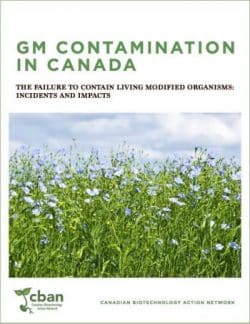
- CBAN Report: GM Contamination in Canada: The failure to contain living modified organisms – Incidents and impacts. 2019
- CBAN Article A fishy return on investment: The policy collision over genetically modified salmon, Canadian Centre for Policy Alternatives, The Monitor, September/October 2018
- How Canadians Bankrolled the World’s First Genetically Engineered Food Animal: Taxpayers have invested $8.2 million in the development of a rapid-growth salmon that first hit shelves last year. Christopher Pollon, Vice Magazine, March 21 2018



